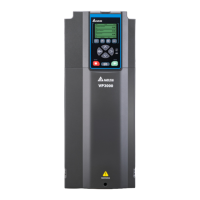6. ASCII mode (LRC Check):
LRC (Longitudinal Redundancy Check) is calculated by summing up the values of the bytes from
ADR1 to the last data character then calculating the hexadecimal representation of the 2’s-
complement negation of the sum. For example: 01H + 03H + 21H + 02H + 00H + 02H = 29H, take
complementary number of 2 = D7H
RTU mode (CRC Check):
CRC check is from Address to Data content. It is calculated by the following steps:
Step 1: Load a 16-bit register (called CRC register) with FFFFH.
Step 2: Exclusive OR the first 8-bit byte of the command message with the low order byte of the
16-bit CRC register, and put the result in the CRC register.
Step 3: Examine the LSB of CRC register.
Step 4: If the LSB of CRC register is 0, shift the CRC register one bit to the right, fill the value from
Step 3 to CRC register, or the Exclusive OR the CRC register with the polynomial value
A001H, then repeat step 3.
Step 5: Repeat step 3 and 4 until you perform eight shifts. This processes a complete 8-bit byte.
Step 6: Repeat step 2 through 5 for the next 8-bit byte of the command message. Continue doing
this until all bytes are processed. The final contents of the CRC register are the CRC
value. When transmitting the CRC value in the message, the upper and lower bytes of the
CRC value must be swapped, that is, the lower order byte is transmitted first.

